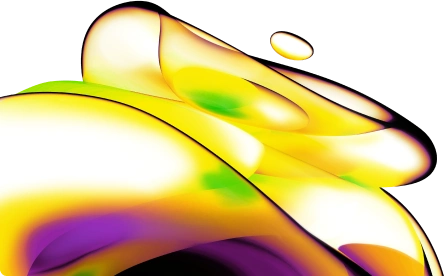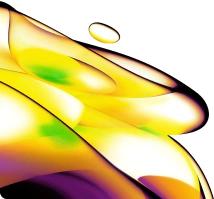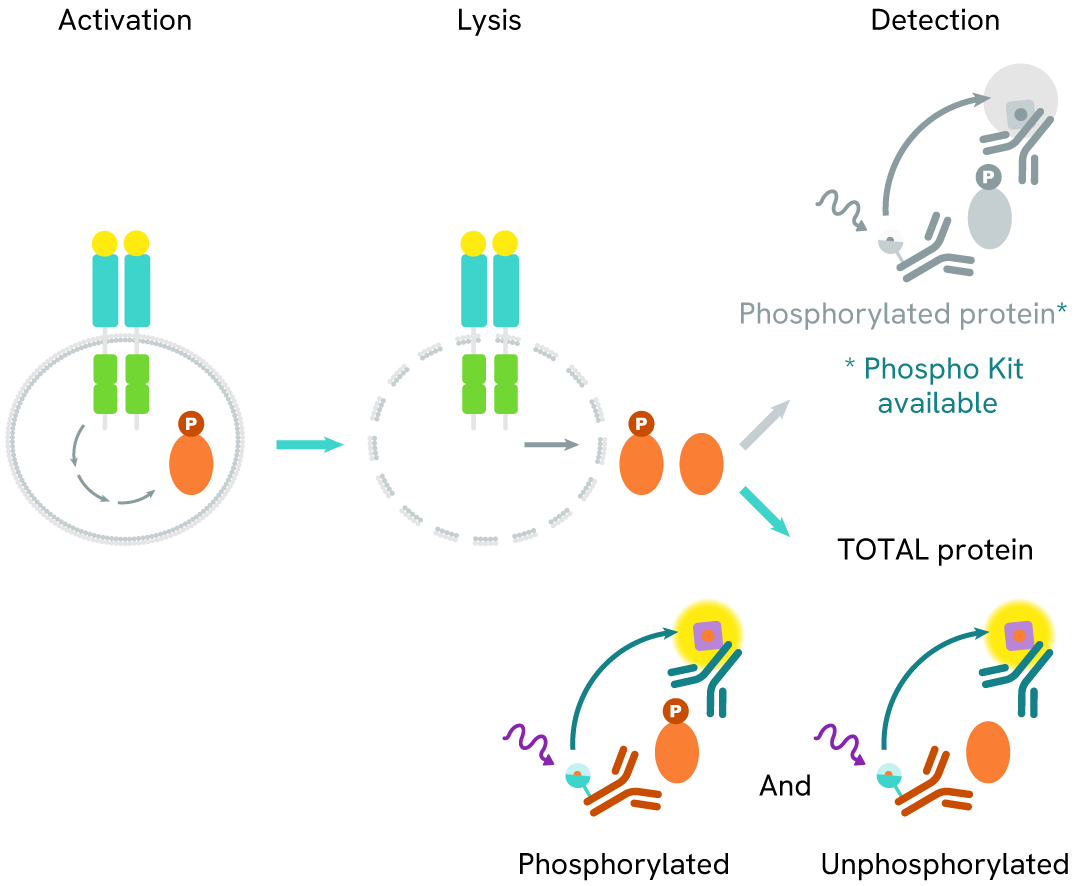

HTRF Human Total Tie2 Detection Kit, 500 assay points
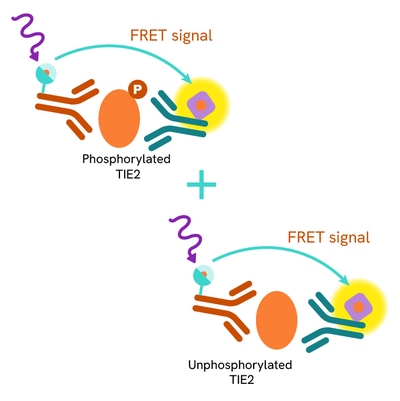
HTRF Human Total Tie2 Detection Kit, 500 assay points
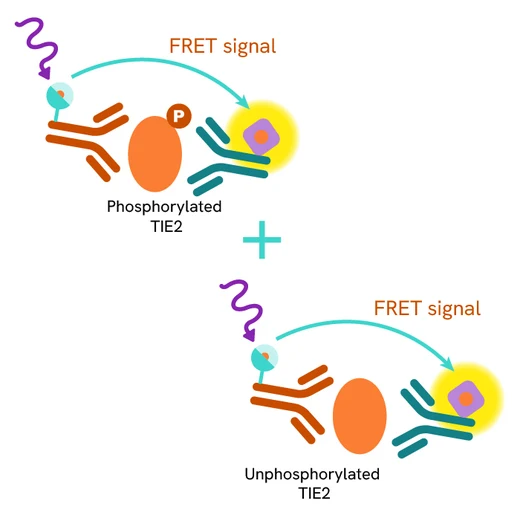

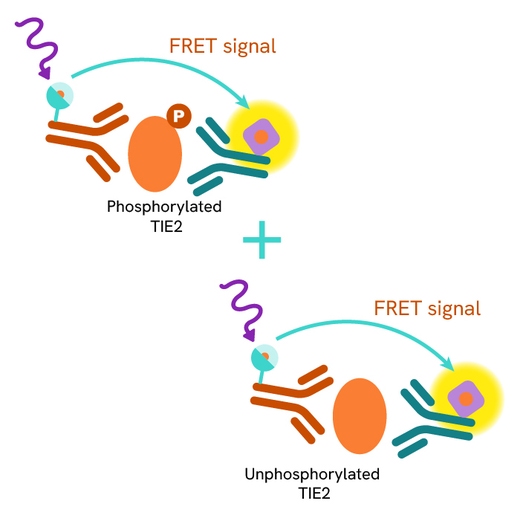

This HTRF kit allows for the cell-based quantitative detection of Total Tie2.
| Feature | Specification |
|---|---|
| Application | Cell Signaling |
| Sample Volume | 16 µL |
This HTRF kit allows for the cell-based quantitative detection of Total Tie2.


HTRF Human Total Tie2 Detection Kit, 500 assay points


HTRF Human Total Tie2 Detection Kit, 500 assay points


Product information
Overview
The Total Tie2 cellular assay kit is designed to monitor the expression level of Tie2, whether phosphorylated or unphosphorylated. It is compatible with our Phospho-Tie2 kit, and enables the analysis of phosphorylated and total proteins from a single sample for better readouts of the angiopoietin/Tie2 signaling pathway.
Tie2 is a tyrosine-protein kinase found in endothelial cells, functioning as a cell-surface receptor for angiopoietins. It plays a key role in regulating angiogenesis, cell migration, survival, adhesion, and proliferation, with its primary function being to maintain vascular stability and quiescence.
Specifications
| Application |
Cell Signaling
|
|---|---|
| Brand |
HTRF
|
| Detection Modality |
HTRF
|
| Lysis Buffer Compatibility |
Lysis Buffer 1
|
| Molecular Modification |
Total
|
| Product Group |
Kit
|
| Sample Volume |
16 µL
|
| Shipping Conditions |
Shipped in Dry Ice
|
| Target |
Tie2
|
| Target Class |
Phosphoproteins
|
| Target Species |
Human
|
| Technology |
TR-FRET
|
| Therapeutic Area |
Oncology
|
| Unit Size |
500 assay points
|
How it works
Total Tie2 assay principle
The Total Tie2 assay quantifies the expression level of Tie2 in a cell lysate. Unlike Western Blot, the assay is entirely plate-based and does not require gels, electrophoresis, or transfer. The Total Tie2 assay uses two labeled antibodies, one coupled to a donor fluorophore and the other to an acceptor. Both antibodies are highly specific for a distinct epitope on the protein. In the presence of Tie2 this enables an immune-complex formation involving both labeled antibodies, and which brings the donor fluorophore into close proximity to the acceptor, thereby generating a FRET signal.
Its intensity is directly proportional to the concentration of total protein present in the sample and provides a means of assessing the protein's phosphorylation state under a no-wash assay format.

Total Tie2 two-plate assay protocol
The two-plate protocol involves culturing cells in a 96-well plate before lysis, then transferring lysates into a 384-well low volume detection plate before the addition of HTRF Total Tie2 detection reagents. This protocol allows for the cells' viability and confluence to be monitored.
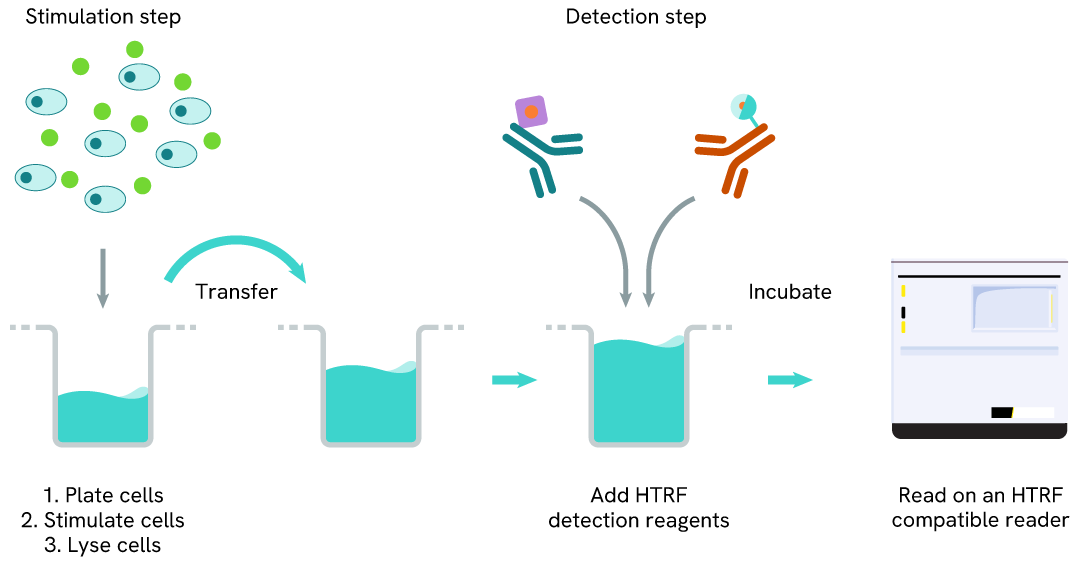
Total Tie2 one-plate assay protocol
Detection of Total Tie2 with HTRF reagents can be performed in a single plate used for culturing, stimulation, and lysis. No washing steps are required. This HTS designed protocol allows miniaturization while maintaining robust HTRF quality.
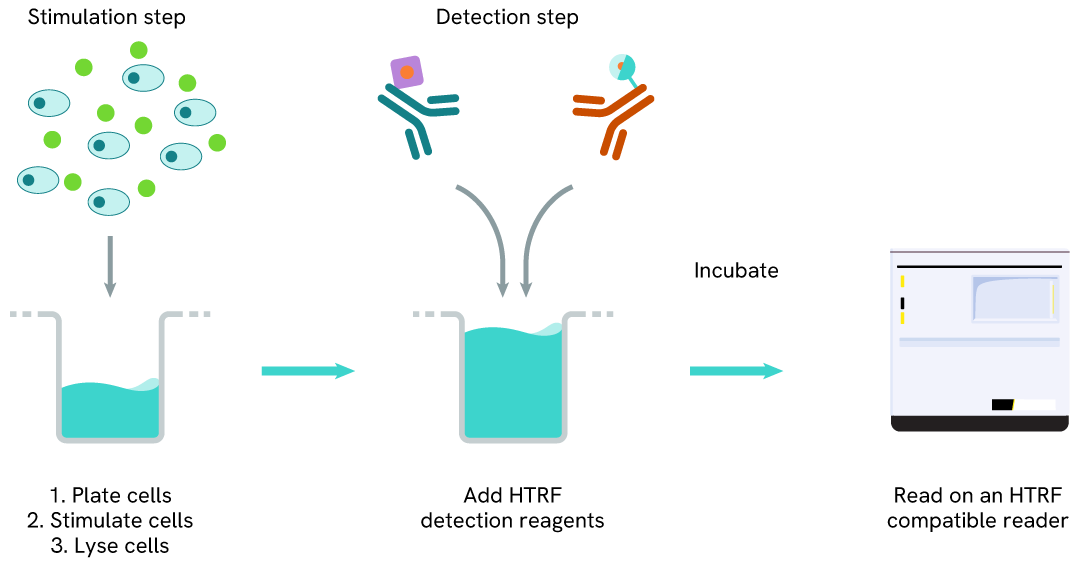
Assay validation
Induction of Phospho-Tie2 (Tyr992) in a cellular model overexpressing Tie2
HEK293T cells were seeded in a 96-well culture-treated plate (12,500 cells/well) in complete culture medium and incubated overnight at 37°C, 5% CO2. The cells were transfected with the Tie2 plasmid or with an empty plasmid as a control.
After 24 hours of incubation, the cells were treated with increasing concentrations of Pervanadate (dose response) or with Angiopoietin-1 alone (625 ng/mL) and/or Pervanadate (1.25 µM) for 30 minutes (histogram).
After treatment, the cells were lysed with 50 µL of supplemented lysis buffer #1 for 30 minutes at room temperature under gentle shaking. For the detection step, 16 µL of cell lysate were transferred into a 384-well low-volume white microplate, and 4 µL of the HTRF Phospho-Tie2 (Tyr992) or Total Tie2 detection reagents were added. The HTRF signal was recorded after an overnight incubation.
As expected, the Total Tie2 assay showed a constant level of Total Tie2 under Pervanadate or Angiopoietin-1, whereas the treatment triggered a dose-dependent increase in the level of Phospho-Tie2.
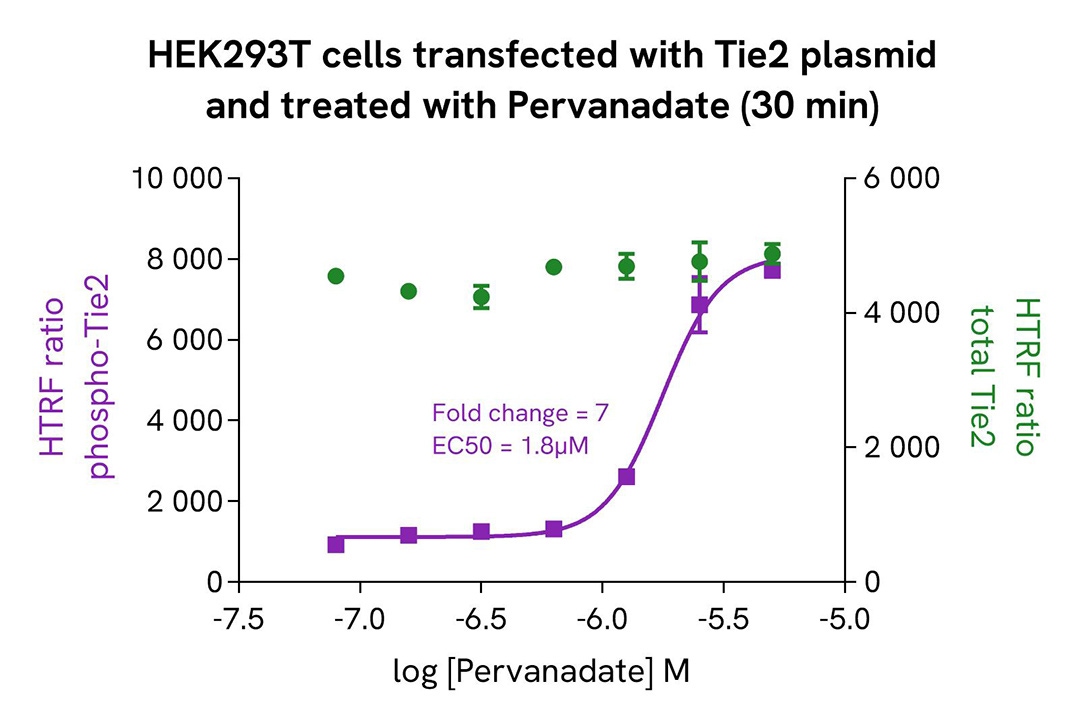
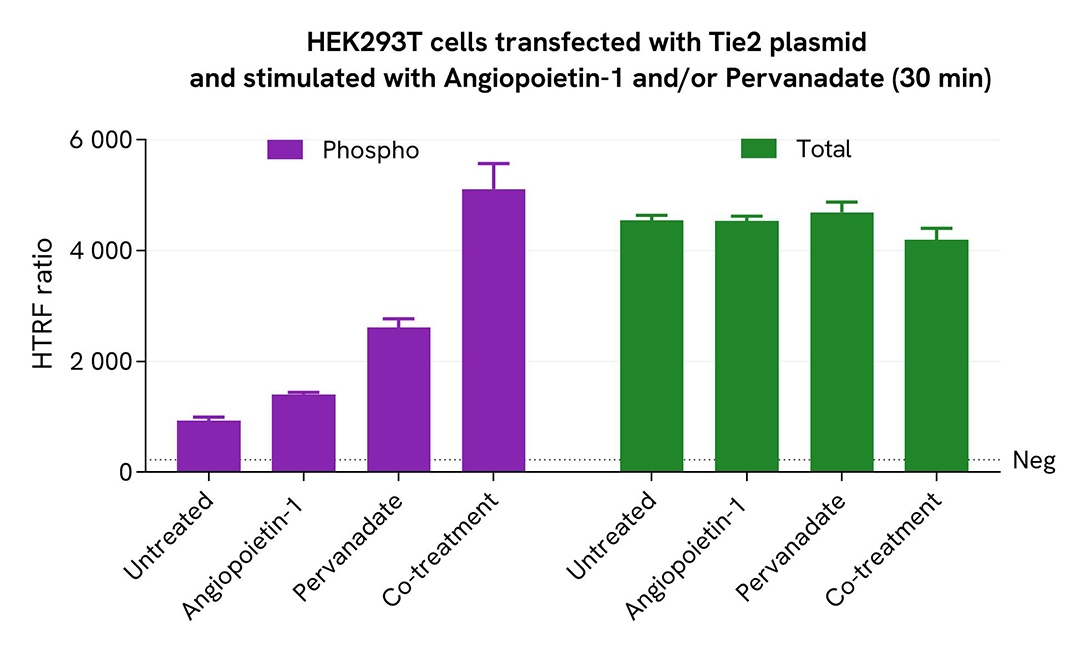
Inhibition of Phospho-Tie2 (Tyr992) in a cellular model overexpressing Tie2
HEK293 cells were seeded in a 96-well culture-treated plate (12,500 cells/well) in complete culture medium and incubated overnight at 37°C, 5% CO2. The cells were transfected with the Tie2 plasmid. After 24 hours, the cells were treated for 1 hour with increasing doses of the Tie2 Tyrosine Kinase Inhibitor, and 600 ng/mL of Angiopoietin-1 or 1 µM of Pervanadate were added 30 minutes before the end of the treatment.
The cells were lysed with 50 µL of supplemented lysis buffer #1 for 30 minutes at room temperature under gentle shaking. For the detection step, 16 µL of cell lysate were transferred into a 384-well low-volume white microplate, and 4 µL of the HTRF Phospho-Tie2 (Tyr992) or Total Tie2 detection reagents were added. The HTRF signal was recorded after an overnight incubation.
As expected, the Tie2 kinase inhibitor led to a dose-dependent reduction in Tie2 phosphorylation, while the expression level of the receptor was not affected.

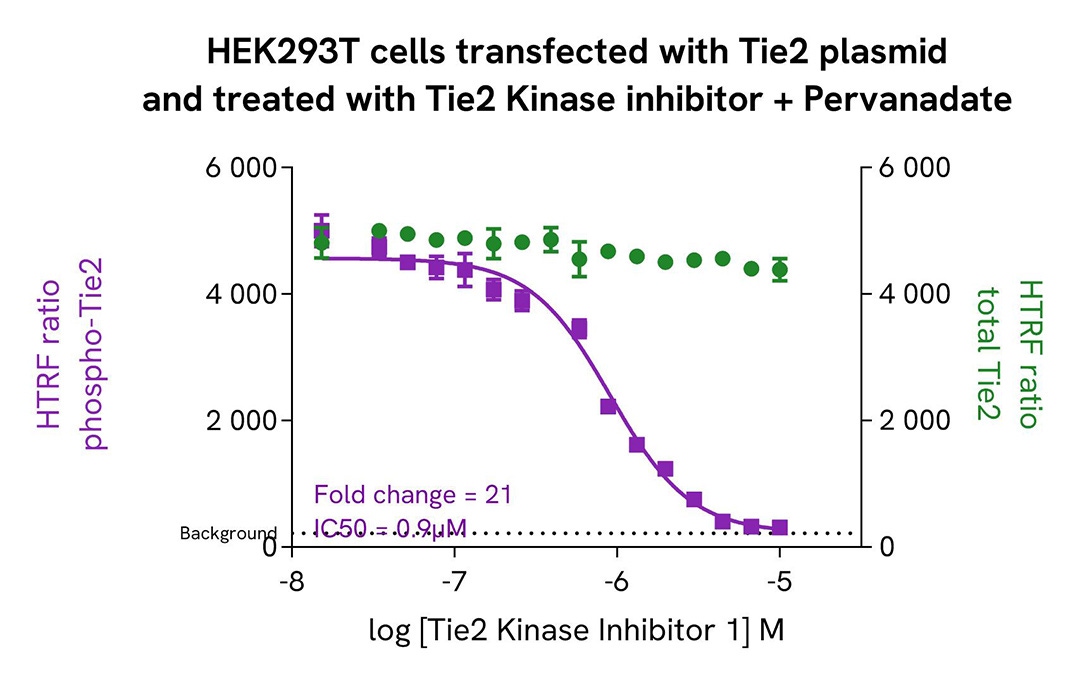
Specificity of Total Tie2 assay using transfection of Tie1 & Tie2
HEK293 cells were plated in a 96-well plate (12,500 cells/well) and cultured for 24 hours. The cells were then transfected with different plasmids, Tie1 and Tie2, as well as with a negative control. After 24 hours of incubation, the cells were treated for 30 minutes with 100 µM of Pervanadate before being lysed with 50 µL of supplemented lysis buffer #1 (1X) for 30 minutes at room temperature under gentle shaking.
After cell lysis, 16 µL of lysates were transferred into a 384-well low-volume white microplate, and 4 µL of the HTRF Total Tie2 detection antibodies were added. The HTRF signal was recorded after an overnight incubation.
Cell transfection with Tie2 led to the detection of the receptor compared to the negative control (untransfected). In contrast, transfection with Tie1 did not lead to any signal increase, demonstrating that the HTRF Total Tie2 assay is specific for Tie2, as expected, and does not cross-react with the Tie1 family member.
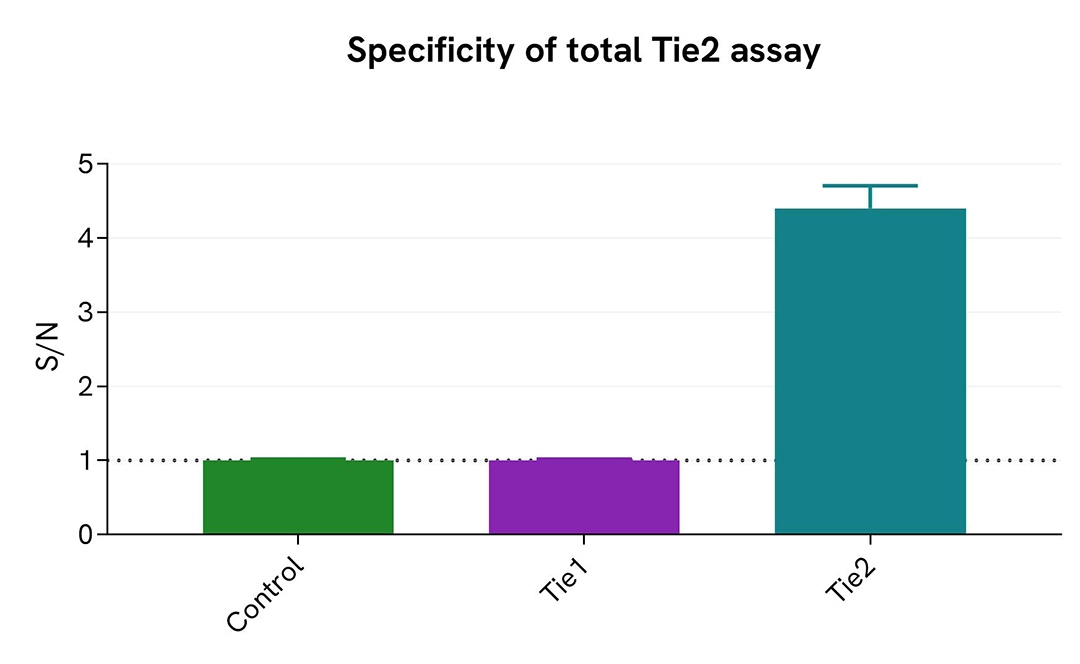
HTRF Total Tie2 assay compared to Western Blot
HEK293 cells were grown in a T175 flask in complete culture medium at 37°C, 5% CO2, until 80% confluence. The cells were then transfected with the Tie2 plasmid for 24 hours before Pervanadate treatment (100 µM, 30 minutes). After 24 hours of incubation, the cells were lysed with 3 mL of supplemented lysis buffer #1 (1X) for 30 minutes at room temperature under gentle shaking.
Serial dilutions of the cell lysate were performed using supplemented lysis buffer, and 16 µL of each dilution were transferred into a low-volume white microplate before the addition of 4 µL of HTRF Total Tie2 detection reagents. Equal amounts of lysates were used for a side-by-side comparison between HTRF and Western Blot.
Using the HTRF Total Tie2 assay, 30 cells/well were enough to detect a significant signal, while 30,000 cells were needed to obtain a minimal chemiluminescent signal using Western Blot. Therefore, under these conditions, the HTRF Total Tie2 assay was 1,000 times more sensitive than the Western Blot technique.
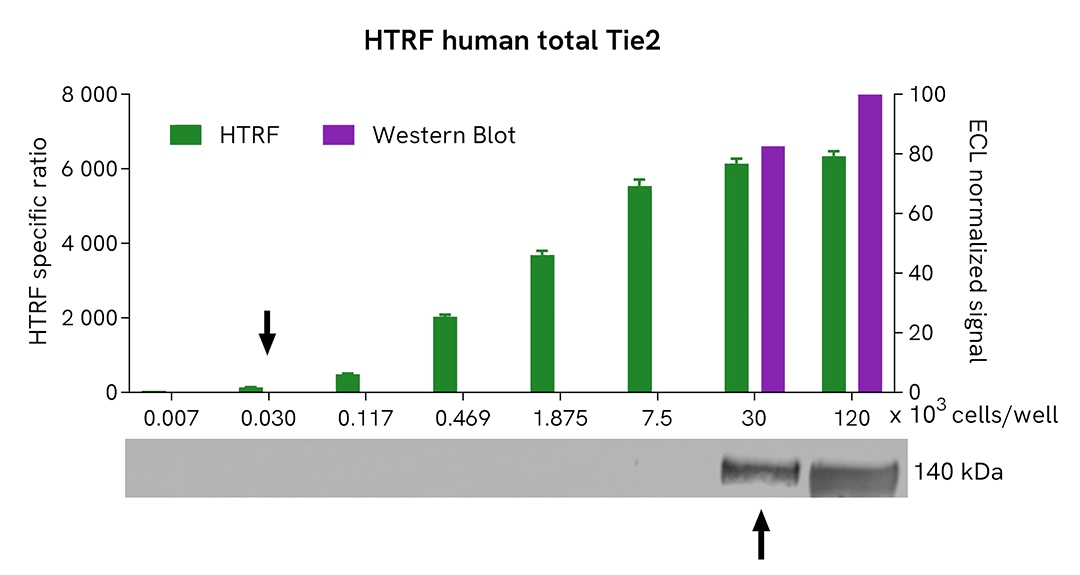
Simplified pathway
Tie2 signaling pathway
Tie2 (TEK receptor tyrosine kinase) protein induces angiogenesis and supports endothelial cell survival upon binding of an endothelial growth factor, angiopoietin-1 (Angpt1), to the receptor. In the presence of Angiopoietin 1, receptors form homodimers, followed by the autophosphorylation of the C-terminal tails at Tyrosine 992 and activation of downstream signaling pathways, including MEK/ERK, IKKβ/NFκB, and AKT. The overall activation results in the maintenance of vascular stability, cellular proliferation, reduction of inflammation, and cell survival. Downregulation is induced by two mechanisms: deactivation of active Tie2 by vascular endothelial protein tyrosine phosphatase (VE-PTP), and binding of the non-activating ligand angiopoietin-2 (Angpt2).
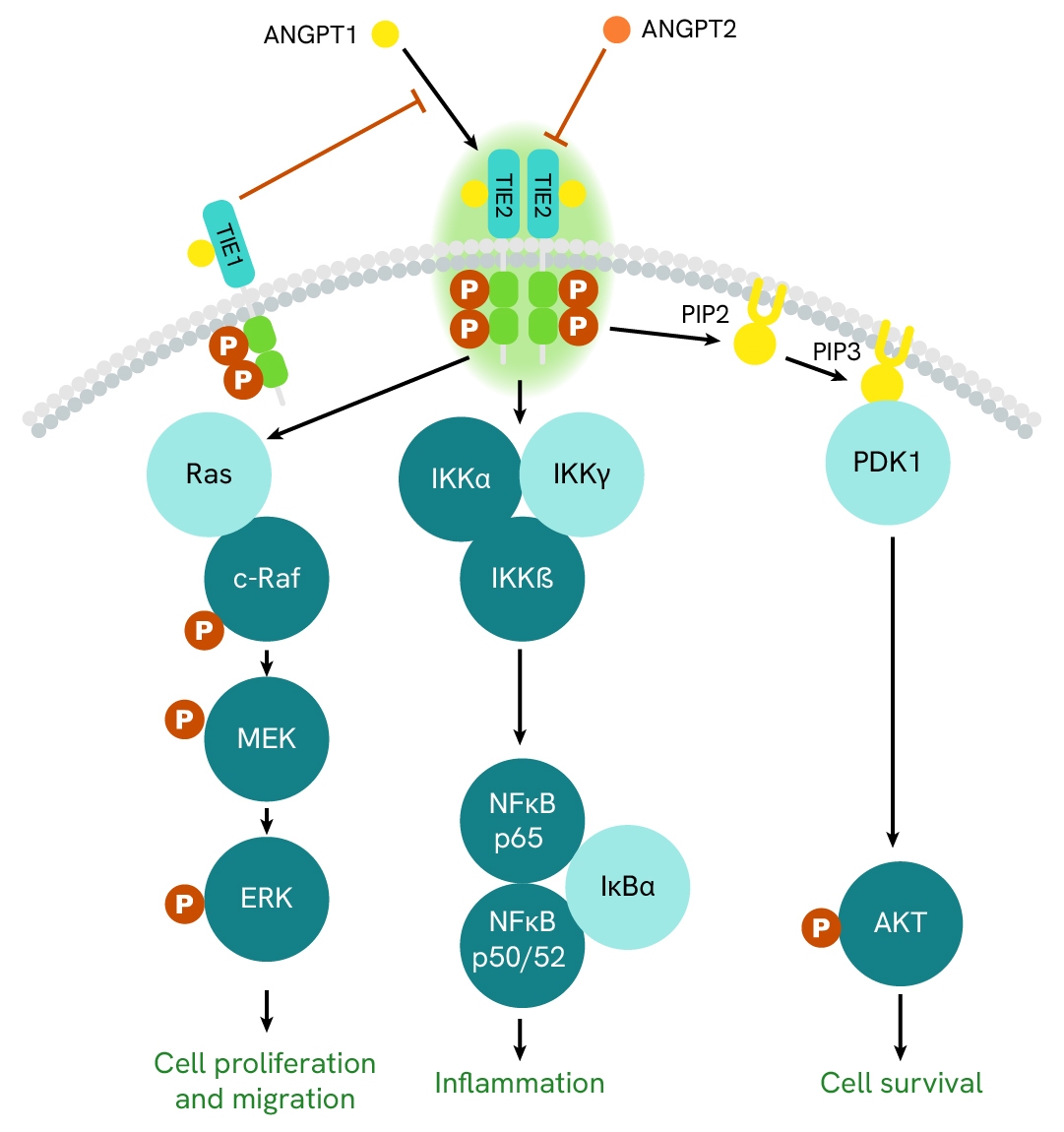
Resources
Are you looking for resources, click on the resource type to explore further.
Discover the versatility and precision of Homogeneous Time-Resolved Fluorescence (HTRF) technology. Our HTRF portfolio offers a...
Loading...


How can we help you?
We are here to answer your questions.
